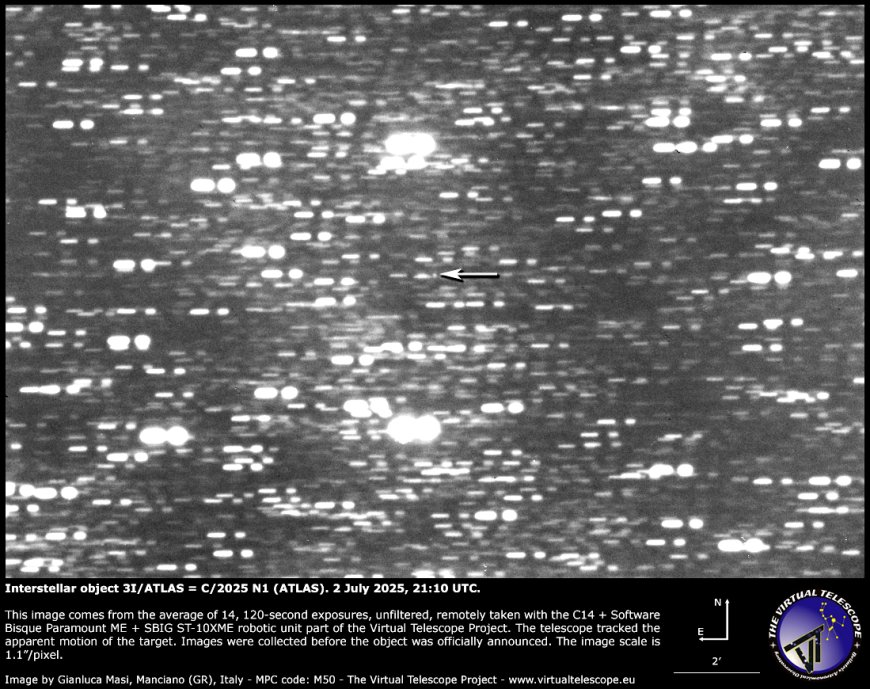Interstellar Object 3I/ATLAS = C/2025 N1 (ATLAS): A Rare Celestial Discovery
On July 1st, astronomers found a celestial body, 3I/ATLAS = C/2025 N1 (ATLAS), passing through our Solar System from beyond. It's only the third of its kind ever spotted. Check out the image of this unique object here.

On July 1st, astronomers discovered a celestial body passing through the region of the Sun, but originating from beyond the Solar System: it is 3I/ATLAS = C/2025 N1 (ATLAS). It’s the 3rd ever of this kind. We imaged it and share our picture here.
On July 1st, astronomers discovered a celestial body passing through the region of the Sun, but originating from beyond the Solar System. Initially designated A11pl3Z, it received its official name just a few hours ago: 3I/ATLAS = C/2025 N1 (ATLAS). This is only the third such object ever found, after 1I/ʻOumuamua in 2017 and 2I/Borisov in 2019.
It was first spotted by the Chilean station of the ATLAS project, dedicated to the search for near-Earth asteroids, but previous unnoticed images of the object were soon found. The Minor Planet Center promptly called for necessary follow-up observations and published preliminary data on its website, along with the temporary designation A11pl3Z, under which the object quickly gained attention.
From the beginning, its interstellar nature was evident due to its high velocity at infinity (hyperbolic excess velocity) of nearly 60 km/s, corresponding to a strongly hyperbolic orbit with an eccentricity of 6.2—by far the highest among the three interstellar objects known to date.
At the time of discovery, 3I/ATLAS was about 520 million km from Earth and 670 million km from the Sun, within Jupiter’s orbit and rapidly approaching. Its brightness was around magnitude 18.5, making it about 2.5 million times fainter than Polaris. It is currently photographable with telescopes of approximately 150–200 mm in aperture.
Within 24 hours, the first signs of cometary activity were reported, leading to the additional designation C/2025 N1. Currently, its estimated diameter is around 20 km, though this comes with significant uncertainty due to limited data and the object’s true brightness, which may currently be boosted by a temporary outburst.
3I/ATLAS will reach perihelion (closest point to the Sun) on October 29, passing at just over 200 million km from our star at a speed of about 68 km/s. On October 2, it will be only 30 million km from Mars, and on December 19, it will make its closest approach to Earth, passing at around 270 million km from our planet.
From Earth, 3I/ATLAS is currently visible in the constellation Sagittarius, transiting in the southern sky in the middle of the night. As mentioned, it can be photographed using telescopes with at least 150–200 mm of aperture, but the full Moon on the 10th will soon make observations increasingly difficult. In the coming months, however, it will become easier to observe even with small instruments.
I personally observed 3I/ATLAS on the evening of July 2, before its official announcement. The observation was made using a 360 mm telescope located in Manciano (GR), Italy, under one of the darkest skies of the Italian mainland. The resulting image is attached.
I have also created the attached star map, showing the path of 3I/ATLAS among the stars until December 30, 2025.
This evening, July 3, starting at 22:00 UTC the Virtual Telescope Project will stream a live view of the interstellar object 3I/ATLAS on its website.
According to the source: The Virtual Telescope Project 2.0.
What's Your Reaction?
 Like
0
Like
0
 Dislike
0
Dislike
0
 Love
0
Love
0
 Funny
0
Funny
0
 Angry
0
Angry
0
 Sad
0
Sad
0
 Wow
0
Wow
0




































































































































































